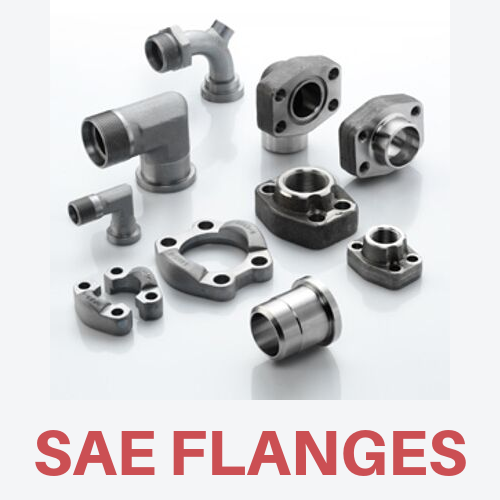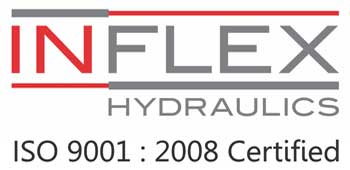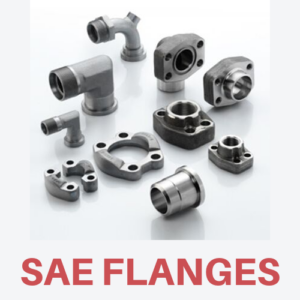SAE Flanges
Hydraulic SAE Flanges: Everything You Need to Know
This article provides an in-depth exploration of SAE Hydraulic flanges. As critical components in high-pressure applications, these flanges are internationally regarded for their durability and versatility.
Understanding their design, construction, and industry standards is vital for optimal utilization. This comprehensive guide examines the different types, their industrial applications, and comparative advantages, equipping professionals with the knowledge necessary for efficient and effective use of SAE Hydraulic flanges in their respective fields.
Key Takeaways
- Hydraulic flanges provide an alternative method of connecting pipes, hoses, tubes, or equipment, particularly suitable for high pressures, larger sizes, and tight quarters assembly.
- SAE Hydraulic flanges conform to SAE J518 and ISO 6162 standards and are available in different bolt grades and materials such as carbon steel, stainless steel, and galvanized material.
- O-ring sealing in hydraulic flanges provides reliable soft sealing for joints and pressurized fluid containment, preventing leakage.
- There are two different code designs for SAE Hydraulic flanges: code 61 and code 62, with different working pressures and size ranges.
Understanding SAE Hydraulic Flanges
To fully understand the intricacies of SAE Hydraulic Flanges, it’s essential to delve into their distinct features, design codes, and the significant role they play in hydraulic systems.
Hydraulic flanges provide a robust and secure connection in hydraulic applications, catering to high pressures and diverse SAE Hydraulic flange sizes. Their SAE Hydraulic flange dimensions are strictly compliant with SAE J518 and ISO 6162 standards, thereby ensuring uniformity and compatibility.
The Hydraulic SAE flange dimensions range from 3/8 to 5 inches, covering both Code 61 and Code 62 series. The incorporation of O-ring sealing reduces leakage risks, offering reliable soft sealing. With SAE flange hose fittings, they allow zero-clearance assembly and infinite positioning, enhancing their versatility in hydraulic systems.
Diverse Types of SAE Hydraulic Flanges
In the realm of hydraulic systems, there are diverse types of SAE Hydraulic flanges, each designed to meet specific application requirements and connection standards. The SAE flange catalogue includes the SAE blind flange and SAE split flange, among others.
These flanges are made with precision during flange manufacturing to ensure optimal performance. The SAE split flange, for instance, is designed for ease of assembly and disassembly in tight spaces. On the other hand, the SAE blind flange seals an end pipe, providing a clean and secure stop.
Furthermore, the hydraulic SAE flange code, either code 61 or 62, determines the flange’s pressure capacity and size range. Understanding these diverse types of SAE Hydraulic flanges aids in selecting the appropriate component for each hydraulic application.
Quick facts about SAE Hydraulic flanges:
- Connection Types: SAE Hydraulic flanges can be attached to pipes using threaded end (NPT or BSPP) or welding end (socket weld or butt weld) connections
- Configuration: The complete set of SAE Hydraulic flanges includes a flat face, o-ring face, o-ring groove, 4 washers, and cap screws
- Series: SAE Hydraulic flanges come in different series, including Code 61, Code 62, Series 3000, and Series 6000
- Size: SAE Hydraulic flanges range in size from 3/8″ to 5″
- Working Pressure: SAE Hydraulic flanges can withstand working pressures ranging from 34 to 345 bar for Code 61 and up to 414 bar for Code 62
Hydraulic SAE Flanges: Design and Construction
The design and construction of SAE Hydraulic flanges involve precise methods to create a robust and reliable connection for tubes, hoses, pipes, and other fittings. These flanges are designed to conform to SAE J518 and ISO 6162 standards, ensuring a high-pressure, leak-free connection.
They are typically made of carbon steel, offering strength and durability for a range of applications. Variations such as the SAE split and SAE blind flanges are available, each catering to specific connection needs.
The complete set, including flange adapters, clamps, and block fittings, ensures a secure fit and optimal performance. Notably, blind flanges provide a means to block off the 4-bolt flange port, contributing to the overall versatility of the system.
Industrial Applications of SAE Flanges
Building upon their robust design and construction, SAE Hydraulic flanges’ versatility extends to a wide range of industrial applications. Their high-pressure resistance, with a continuous pressure level of 6,000 PSI, makes them suitable for many hydraulic systems.
The flanges, designed under two codes, code 61 and 62, are utilized for different pressure ratings. The split flange design allows easy disassembly, vital for maintenance and modifications. SAE Hydraulic flanges accommodate hoses, with a secure seal ensured by an o-ring. Welding connections, including socket and butt weld, offer reliability and durability. The socket weld, in particular, is a prevalent choice for pipe diameters under 2 inches.
Thus, the SAE flange’s adaptability, coupled with its robust construction, supports its broad industrial utility.
Strict Standards for SAE Flange Manufacturing
Adhering to rigorous standards in SAE flange manufacturing is paramount, considering the critical role these components play in diverse industrial applications. The manufacturing process is governed by ISO 6162/SAE J518 specifications, ensuring high pressure and temperature resilience.
Flanges are engineered with different thread types such as UNC, NPT, and BSPP to accommodate versatile connection needs. The flat face of the flange is meticulously designed for cap screws, ensuring a secure and tight junction.
The types of connection offered include threaded end and welding end, each designed for specific applications and pressures. All these features are forged under strict protocols to withstand high pressures, thus solidifying the flange’s crucial role in industrial settings.
Stainless steel SAE hydraulic flanges are a type of flange that meets SAE J518 and ISO 6162 standards. They are designed to provide leak-free connections for high-pressure and large-size hydraulic systems. Available in sizes from 3/8″ to 5″, stainless steel SAE hydraulic flanges can be connected using butt weld, socket weld, or threaded connections (BSPP, NPT, metric, or JIC). Code 61 flanges have a working pressure of up to 210 Bar (3000 PSI), while Code 62 flanges can withstand up to 420 Bar (6000 PSI). Stainless steel SAE hydraulic flanges are widely used in industrial hydraulics, mobile hydraulics, and shipbuilding. They offer several advantages over other types of connectors, including higher pressure resistance, better shock and vibration resistance, and easier installation in confined spaces.
Comparing Hydraulic SAE and Other Flanges
Given the stringent manufacturing standards and unique features of SAE Hydraulic flanges, a comparison with other types of flanges can further highlight their distinctive advantages and potential applications.
Unlike traditional flanges, SAE Hydraulic flanges are renowned for their high-pressure endurance, versatility in assembly sites, and global standard acceptance.
Manufactured from normalized forging with low carbon content, these flanges exhibit superior strength and durability.
Their sealing mechanism, featuring a high durometer O-ring, ensures reliable fluid containment under heavy-duty operations.
The bolt grades vary according to the application, providing customization options for diverse industrial environments.
Additionally, their two code designs, Code 61 and 62, offer flexibility in working pressure ranges, affirming their adaptability in various hydraulic systems.
Advantages of Hydraulic SAE Over Welded Flanges
While the comparison with other types of flanges underscores the unique advantages of SAE Hydraulic flanges, it’s crucial to specifically highlight how they outperform welded flanges in various aspects.
SAE Hydraulic flanges offer robustness and ease of assembly, a stark contrast to welded flanges. Their zero-clearance assembly allows for easy connection, disconnection, and maintenance, a feature absent in welded flanges.
Furthermore, the infinite positioning capability of SAE Hydraulic flanges enables flange orientation at any angle, providing flexibility in installation. They also exhibit a higher pressure tolerance, making them suitable for demanding applications.
Lastly, SAE Hydraulic flanges employ a single seal point, reducing the scope for leakage, and they require less tightening torque, thus ensuring a reliable and efficient connection.
Frequently Asked Questions
What Are Some Safety Measures to Consider When Installing Hydraulic SAE Hydraulic Flanges?”
When installing hydraulic SAE Hydraulic flanges, safety measures include proper torque application, ensuring compatibility of components, regular maintenance checks, correct use of O-rings for sealing, and adherence to installation guidelines and standards.
Are There Any Specific Maintenance Routines Recommended for SAE Flanges?”
Regular maintenance of SAE Hydraulic flanges involves periodic inspections for leaks or damage, ensuring proper torque on bolts, and replacing the O-ring seals when necessary to maintain optimal performance and prevent system failures.
What Are the Differences Between SAE Hydraulic Flanges and Other Flanges in Terms of Cost?”
SAE Hydraulic flanges often have a higher initial cost than other flanges due to their robust design and high-pressure capacity. However, their ease of installation and maintenance can result in lower long-term operational costs.
How Does the Performance of Hydraulic SAE Flanges Compare Under Extreme Temperatures or Corrosive Environments?”
Hydraulic SAE Hydraulic flanges perform well under extreme temperatures and corrosive environments. The use of bolt grade 10.9 withstands high temperatures, while SS316 flanges and bolts offer superior corrosion resistance, ensuring durable and reliable connections.
Are There Any Industry-Specific Adaptations or Variations of Hydraulic SAE Flanges?”
Yes, Hydraulic SAE flanges can be adapted to industry-specific needs. Variations exist in terms of material, pressure handling capacities, bolt grades, and connection types to ensure optimal performance in different work environments.
Conclusion
In conclusion, Hydraulic SAE flanges are a fundamental component in numerous high-pressure applications, owing to their robustness, versatility, and adherence to international standards. Their unique design, coupled with advantageous features such as O-ring sealing and easy installation, substantiates their superiority over other flange types.
Their use across diverse industries underscores their utility and efficiency.
If you are looking for a durable, reliable, and versatile flange for your hydraulic system, then SAE flanges are the perfect choice for you. Order your SAE flanges today from Inflex Hydraulics! We offer a wide selection of SAE flanges at competitive prices.
Trouble shooting common problems in SAE flanges
SAE Flanges – step by step installation guide
Common types of materials used for SAE Flanges


